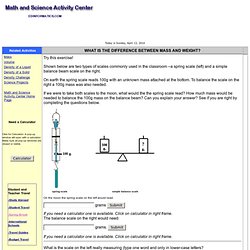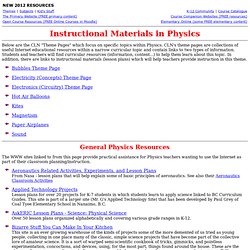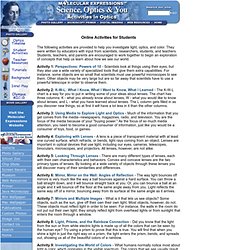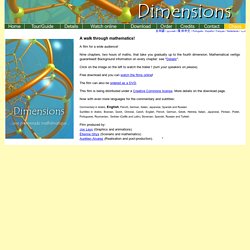

The Theory of Relativity, For Kids - Trending Sideways. So you want to understand the theory of relativity, and you’re a kid?

No problem. Let’s get started. (If you’re a parent looking for some activities to help teach your kid, consider ordering Albert Einstein and Relativity for Kids: His Life and Ideas with 21 Activities and Thought Experiments. And if you’re an adult who just wants to understand relativity, there’s no shame in reading on.) Light Always Moves the Same Speed A long time ago, scientists wanted to figure out how fast the earth was moving through space. TED-Ed and Periodic Videos. Saylor.org – Free Online Courses Built by Professors. Understanding Science.
Learn AP Physics - AP Physics B. Video lesson on Motion in One Dimension (external link) Your email address will not be shared.

See our Terms of Service for more info on how your privacy is protected. You'll receive a new AP Physics-style multiple-choice problem delivered to your email inbox each weekday. Click on the link in the email to see the solution. This non-calculus, college-level physics curriculum includes Newtonian mechanics, thermodynamics, waves, sound, optics, electricity, magnetism, atomic physics, nuclear physics, and relativity. While there are distinct advantages to learning--either in a classroom or online--with a real physics teacher, there are a number of online references that can help supplement your instruction.
Links to Online Video Lessons AP Lessons from the Monterey Institute for Technology & EducationMIT OpenCourseWare AP PhysicsThe Mechanical Universe and Beyond (requires free registration, or see individual lesson links below) Video Lessons & Problems, Organized by Unit. Physics Study Guides - SparkNotes. Welcome to Amusement Park Physics. Forces. 8.02 Video Lectures. 1-D Kinematics - Table of Contents. Isaac Newton's Laws of Motion. Isaac Newton's Laws of Motion. What is the Difference between Mass and Weight? What did the above experiment demonstrate?

It shows that the scale on the left was measuring the force of gravity (weight) not mass. On earth the spring was standardized to read 100g at sea level. A true balance beam (like a triple beam balance you use at school) measures mass by balancing the scale against a known (standardized) mass. On the moon the mass on the left side of the balance may 'exert less force', but then less force will be needed to balance it. So what is really mass and weight if they are not the same thing? Mass is defined as the amount of matter an object has.
The weight of an object on earth depends on the force of attraction (gravity) between the object object and earth. Instructional Materials in Physics. Instructional Materials in Physics Below are the CLN "Theme Pages" which focus on specific topics within Physics.

CLN's theme pages are collections of useful Internet educational resources within a narrow curricular topic and contain links to two types of information. Students and teachers will find curricular resources (information, content...) to help them learn about this topic. In addition, there are links to instructional materials (lesson plans) which will help teachers provide instruction in this theme. The Electromagnetic Spectrum. The Electromagnetic Spectrum. Force Equals Mass Times Acceleration: Newton's Second Law. Kinetic and Potential Energy. Thermodynamics. Physics. On Truth & Reality: Philosophy Physics Metaphysics of Space, Wave Structure of Matter. Famous Science Art Quotes. Khan Academy. UPSCALE Home Page. The Physics Classroom. Electricity and Magnetism. Science, Optics and You. Online Activities for Students The following activities are provided to help you investigate light, optics, and color.

They were written by educators with input from scientists, researchers, students, and teachers. Students, teachers, and parents are encouraged to work together to begin an exploration of concepts that help us learn about how we see our world. Activity 1: Perspectives: Powers of 10 - Scientists look at things using their eyes, but they also use a wide variety of specialized tools that give them extra capabilities. For instance, some objects are so small that scientists must use powerful microscopes to see them. Activity 2: K-W-L: What I Know, What I Want to Know, What I Learned - The K-W-L chart is a way for you to put in writing some of your ideas about lenses.
Activity 3: Using Media to Explore Light and Optics - Much of the information that you get comes from the media--newspapers, magazines, radio, and television. HPS 0410 Einstein for Everyone. Title page, Preface and Table of Contents for Einstein for Everyone Introduction: the Questions Special Relativity Special Relativity: the Principles.

Dimensions Home. A film for a wide audience!

Nine chapters, two hours of maths, that take you gradually up to the fourth dimension. Mathematical vertigo guaranteed! Background information on every chapter: see "Details". Click on the image on the left to watch the trailer ! Biographies. Chapter 1: Magnetism - Magnetorheological fluids, homemade ferrofluid. Physics Flash Animations. We have been increasingly using Flash animations for illustrating Physics content. This page provides access to those animations which may be of general interest. The animations will appear in a separate window. The animations are sorted by category, and the file size of each animation is included in the listing. Also included is the minimum version of the Flash player that is required; the player is available free from The categories are: In addition, I have prepared a small tutorial in using Flash to do Physics animations.
LInks to versions of these animations in other languages, other links, and license information appear towards the bottom of this page. The Animations There are 99 animations listed below. Other Languages and Links. National High Magnetic Field Laboratory - The Magnetic Field Around a Wire Tutorial (I) Symmetry - Archive: Explain it in 60 Seconds.